Welcome to Julcán, where the skies are filled with the vibrant colors of birds. The vast variety of birds living in and around the city is astounding.
From the majestic Andean Condor to the rare and elusive Black-breasted Hillstar, the birds of Julcán are genuinely something to behold. Whether perched atop a cactus or soaring high in the sky, these birds provide a beautiful and unique view of the city.
So come and explore the feathered friends of Julcán and discover the unique beauty of the birds living here.
24 Birds to Watch in Julcán
Julcán is a city in Peru known for its rich biodiversity and stunning landscapes. It is located in the Andes mountains, near the border with Ecuador. Julcán is a paradise for bird watchers, as it hosts a variety of endemic, rare, or endangered species.
Some of these birds are only found in Julcán or a few other places worldwide. Here are 24 birds that you can watch in Julcán.
1. Cinnamon Teal
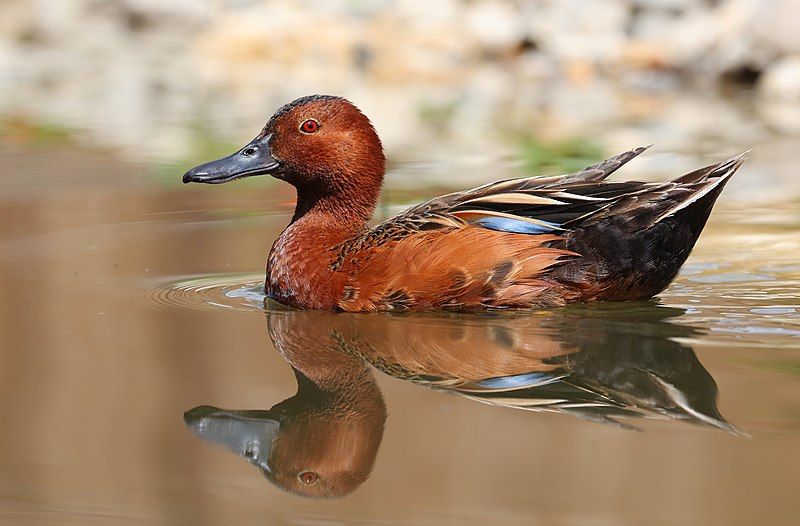
The cinnamon teal is a duck species native to western North and South America. It is a small duck, with males having bright reddish plumage while females are duller in color. This duck prefers to live in marshes and ponds and feeds mainly on plants.
Its small size and bright reddish plumage make it a distinctive duck, making it easy to identify when out in the wild. The cinnamon teal is a dabbling duck, which means it feeds mainly on the water’s surface.
It uses its bill to uproot plant material and to filter out any insects that may be present. Its diet is mainly composed of aquatic plants, seeds, and insects. This duck species can often be found in large flocks, which helps to protect it from predators.
The cinnamon teal is an important species to wetland habitats. It helps maintain the ecosystem’s balance by feeding on plants and insects. This helps to reduce the amount of algae and other aquatic plant species that can overgrow a wetland.
The cinnamon teal also helps to disperse the seeds of aquatic plants, which helps to keep the wetland healthy. The cinnamon teal is an essential duck species in western North and South America.
It helps to maintain the balance of the wetland ecosystem, and its distinct reddish plumage makes it a beautiful species to observe in the wild.
| Kingdom | Animalia |
| Phylum | Chordata |
| Class | Aves |
| Order | Anseriformes |
| Family | Anatidae |
| Genus | Spatula |
| Species | S. cyanoptera |
2. Pied-billed Grebe
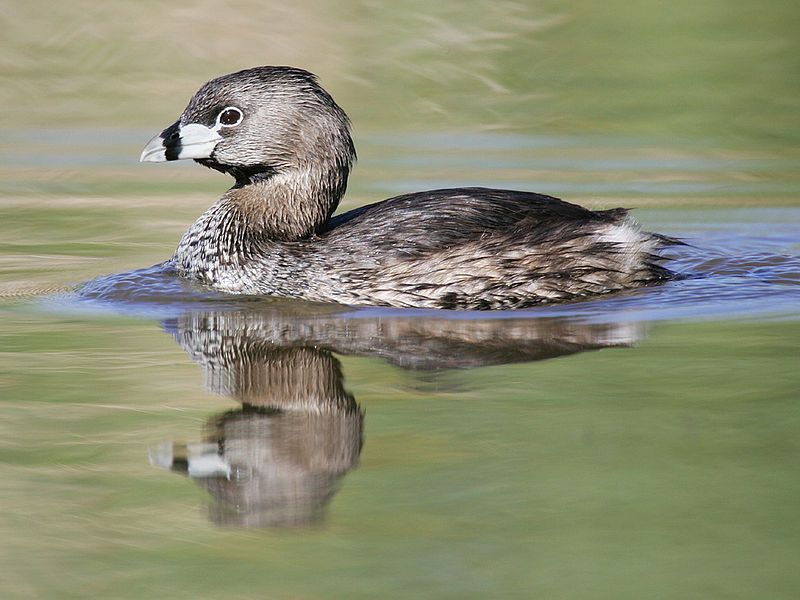
The pied-billed grebe is a species of water bird that belongs to the grebe family. It is the only remaining species of the Podilymbus genus after the Atitlán grebe’s extinction.
This species is native to the Americas and can be seen in ponds or other freshwater habitats such as marshes and lakes. It is a small bird with a short, sharp bill, usually yellow or olive green.
Its back and sides are dark brown or black, and its belly is usually white. The pied-billed grebe has a distinctive “pied” pattern on its bill, with white near its base and darker colors at the tip. Its diet includes aquatic insects, small fish, and other aquatic invertebrates.
It is a solitary bird but will form small flocks when foraging or migrating. Its courtship display is quite elaborate and involves several unique behaviors.
The pied-billed grebe is an essential species in the Americas and is a valuable indicator of the health of wetlands and other aquatic habitats.
| Kingdom | Animalia |
| Phylum | Chordata |
| Class | Aves |
| Order | Podicipediformes |
| Family | Podicipedidae |
| Genus | Podilymbus |
| Species | P. podiceps |
3. Ruddy Duck
The Ruddy Duck is a species of duck native to North America. It belongs to the stiff-tailed duck family of species characterized by their sharp-pointed tails.
The genus name for the Ruddy Duck, Oxurina, is derived from the Ancient Greek words Oxus, meaning “sharp”, and oura, meaning “tail”. The species name, jamaicensis, is derived from the fact that the ducks were first found in Jamaica.
The ruddy duck is a medium-sized duck with a reddish-brown body and white face. They have a long, pointed tail that is often held erect. They are excellent swimmers and divers who feed mainly on aquatic insects and plants.
In winter, they migrate to warmer climates, such as Mexico and Central America.
| Kingdom | Animalia |
| Phylum | Chordata |
| Class | Aves |
| Order | Anseriformes |
| Family | Anatidae |
| Genus | Oxyura |
| Species | O. jamaicensis |
4. Andean Goose
The Andean goose is a species of waterfowl belonging to the Tadornini tribe of the Anserinae subfamily. This species of waterfowl is found in South America, specifically in Argentina, Bolivia, Chile, and Peru.
This goose is native to the Andes Mountains and is known for its striking black and white plumage. It is a medium-sized goose, measuring around 27 inches long and weighing about 4.5 pounds.
The Andean goose is a migratory species, usually breeding and wintering in the same areas. They feed mainly on grasses, aquatic plants, and invertebrates like insects and mollusks.
During the breeding season, the male will construct a nest on the ground, and the female will lay her eggs. The Andean goose is listed as a species of Least Concern by the International Union for Conservation of Nature.
Although its numbers are decreasing due to habitat loss, conservation efforts are being made to protect this species.
| Kingdom | Animalia |
| Phylum | Chordata |
| Class | Aves |
| Order | Anseriformes |
| Family | Anatidae |
| Genus | Chloephaga |
| Species | C. melanoptera |
5. Blue-winged Teal
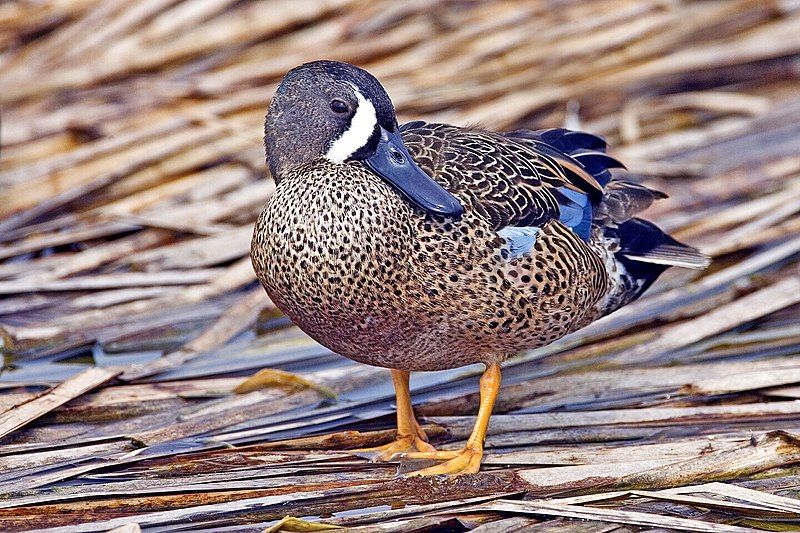
The blue-winged teal is a species of bird that belongs to the family Anatidae, which includes ducks, geese, and swans. It is one of the smaller species of birds in this family, typically found in North America.
Its range extends from southern Alaska to Nova Scotia in the north and northern Texas in the south.
This bird species typically lives in wetlands and can feed in shallow waters. Its distinctive blue wings and yellow-green head indicate the blue-winged teal. It has a white body with brown patches, and its bill is often yellow-green.
The blue-winged teal uses its bill to filter food from the water, picking up insects, crustaceans, and other small aquatic creatures.
During the breeding season, the male blue-winged teal can be seen displaying its vibrant blue wings to attract a mate.
The blue-winged teal is an essential species for wetland conservation, as it helps to maintain a healthy ecosystem by providing food and shelter for other wildlife.
It is also a popular species for hunters, as its meat is quite tasty. The blue-winged teal is an essential species for North America for its ecological and cultural significance.
| Kingdom | Animalia |
| Phylum | Chordata |
| Class | Aves |
| Order | Anseriformes |
| Family | Anatidae |
| Genus | Spatula |
| Species | S. discors |
6. Puna Teal
The Puna teal is a species of duck belonging to the family Anatidae. It is native to the Andes mountain range of South America and is found in Peru, western Bolivia, northern Chile, and extreme northwestern Argentina.
Historically, it was considered a subspecies of the silver teal, but it is now classified as a distinct species. The Puna teal occupies various habitats, from mountains to lakes to pools.
It is especially fond of the larger lakes and pools in the altiplano, the high plateau of the Andes mountains. This species is relatively common and can be found in good numbers.
| Kingdom | Animalia |
| Phylum | Chordata |
| Class | Aves |
| Order | Anseriformes |
| Family | Anatidae |
| Genus | Spatula |
| Species | S. puna |
7. Spot-winged Pigeon
The Spot-winged Pigeon (Columbina maculosa) is a bird species belonging to the Columbidae family, including doves and pigeons. It is native to parts of South America, specifically Argentina, Bolivia, Brazil, Chile, Paraguay, Peru, and Uruguay.
It is a relatively small pigeon with an average length of around 11 inches. Its most distinguishing feature is the large, white-tipped spot on the leading edge of each wing, which gives the bird its name.
The Spot-winged Pigeon is found primarily in dry scrub and savannah habitats but occasionally in more open grasslands. It is an omnivorous bird, feeding mainly on fruits and seeds and taking small insects and other invertebrates.
The Spot-winged Pigeon is generally a solitary species, but it may sometimes form small flocks during the breeding season. The nest is a shallow cup of sticks lined with grass and feathers, usually placed in a tree or bush.
The female lays two white eggs, which both parents incubate for about two weeks. The young birds can fly within a few weeks of hatching and reach maturity after about a year.
| Kingdom | Animalia |
| Phylum | Chordata |
| Class | Aves |
| Order | Columbiformes |
| Family | Columbidae |
| Genus | Patagioenas |
| Species | P. maculosa |
8. Yellow-billed Pintail
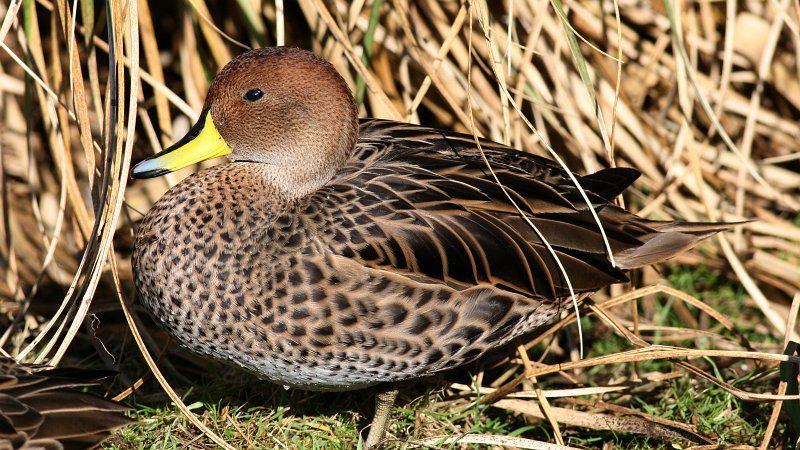
The yellow-billed pintail is a species of duck native to South America. It belongs to the genus Anas, which includes many other species of dabbling ducks.
There are three recognized subspecies of this species, all of which can be found in varying habitats across South America. The most common subspecies is the nominate, which is found in Argentina, Bolivia, Uruguay, Paraguay, and Brazil: the second subspecies, are A.
Georgia is found in Chile and Peru, while the third subspecies, A. versicolor, is found in Ecuador, Colombia, and Venezuela. The yellow-billed pintail is a medium-sized duck with an average length of about 48 cm and a wingspan of approximately 70 cm.
It has a yellow bill, black head, and white neck and breast. Its back is a mottled brown, and its belly is white. The legs and feet are usually dark gray or black. This duck species is generally found in wetlands, such as lakes, ponds, and marshes.
They feed on aquatic plants, insects, and other small animals. The breeding season for the yellow-billed pintail begins in late spring or early summer. The male will nest on the ground, usually near water, and the female will lay a clutch of 6-9 eggs.
The eggs hatch after about 25 days, and the chicks can fly after about six weeks. The yellow-billed pintail is an essential species in the ecosystem as it helps control the population of aquatic insects and other small animals.
It is also a famous game bird hunted by recreational and commercial hunters. As a result, its population has decreased in recent years, and it is now classified as a vulnerable species.
| Kingdom | Animalia |
| Phylum | Chordata |
| Class | Aves |
| Order | Anseriformes |
| Family | Anatidae |
| Genus | Anas |
| Species | A. georgica |
9. Great Grebe
The great grebe is an impressive bird species that is found around the world. It is the largest grebe species, with a leading distribution from extreme southeastern Brazil to Patagonia and central Chile. Interestingly, a disjunct population also exists in northwestern Peru.
This population is slightly different than the leading distribution and is thus considered a separate subspecies, P. m. navasi. This shows that the great grebe is an adaptable species that can thrive in various environments.
It also demonstrates the importance of conserving these populations to ensure the long-term survival of the great grebe.
| Kingdom | Animalia |
| Phylum | Chordata |
| Class | Aves |
| Order | Podicipediformes |
| Family | Podicipedidae |
| Genus | Podiceps |
| Species | P. major |
10. James’s Flamingo
The puna flamingo, also known as James’s flamingo, is a species of bird found in the Andean plateaus of Peru, Chile, Bolivia, and northwest Argentina. It is typically found at high altitudes and is characterized by its striking pink plumage and long legs.
It is a large bird, measuring up to 3.1 feet in height and weighing up to 6.6 pounds. The puna flamingo is named after Harry Berkeley James, a British naturalist who studied the species in the late 19th century.
His research on the bird helped to increase the scientific understanding of the species and its behavior. He is credited with discovering many critical facts about the bird, such as its unique feeding habits and migratory behavior.
His writings and observations are still referenced today by ornithologists and other scientists who study the species. In addition to its scientific importance, the puna flamingo is also a famous bird for birdwatchers.
Its bright pink plumage and long legs make it easily visible, and its habit of living at high altitudes makes it a unique species to observe.
It is also a symbol of nature and conservation in South America, as it is a species endemic to the Andean plateaus and threatened by habitat loss. The puna flamingo is a unique species that has been studied and admired for centuries.
It is an essential species for both conservation efforts and scientific research, and its beauty and grace make it a famous bird for birdwatchers.
Its namesake, Harry Berkeley James, was a pioneer in the study of the species, and his work still influences our understanding of the species today.
| Kingdom | Animalia |
| Phylum | Chordata |
| Class | Aves |
| Order | Phoenicopteriformes |
| Family | Phoenicopteridae |
| Genus | Phoenicoparrus |
| Species | P. jamesi |
11. Puna Tinamou
The Puna Tinamou, also known as Pentland’s Tinamou, is an ancient species of bird belonging to the Tinamou family.
It is native to southern South America and was first described by Nicholas Aylward Vigors in 1837, with the binomial name of the species honoring Irish natural scientist Joseph Barclay Pentland.
This bird species is unique in that it is one of the oldest still-existing bird families, having changed little since its origin. The Puna Tinamou is a medium-sized ground bird, approximately 30 cm (12 in) long, with a short tail and rounded wings.
It has a mainly grey-brown plumage with a black face and white throat. It is a skulking bird that prefers to stay hidden in dense vegetation. It feeds primarily on insects, seeds, and other small animals and is usually found in small flocks of up to 10 individuals.
The Puna Tinamou is classified as of least concern by the IUCN, as it is widespread and locally common throughout its range, and its population is thought to be stable.
| Kingdom | Animalia |
| Phylum | Chordata |
| Class | Aves |
| Order | Tinamiformes |
| Family | Tinamidae |
| Genus | Tinamotis |
| Species | T. pentlandii |
12. Silvery Grebe
The Silvery Grebe is a unique species of grebe with an impressive range. It is a member of the Podicipedidae family and can be found in the western and southern parts of South America. This bird prefers to inhabit freshwater lakes but can also be found in saline lakes.
Its range covers altitudes of up to 4,000 meters, making it an adaptable species. This species has a slender body, a long neck, and a bright yellow bill. Its most identifiable feature is the silvery grey feathers that cover its body.
The Silvery Grebe is a strong swimmer known to dive for food. It primarily feeds on small fish, insects, crustaceans, and mollusks that it finds in the water. The Silvery Grebe is a migratory species and can often be found in large flocks during the winter months.
During mating season, the males can be seen displaying their feathers to attract a mate. The Silvery Grebe is an integral part of its habitat and provides an essential food source for other species, which helps maintain the balance of the local ecosystem.
| Kingdom | Animalia |
| Phylum | Chordata |
| Class | Aves |
| Order | Podicipediformes |
| Family | Podicipedidae |
| Genus | Podiceps |
| Species | P. occipitalis |
13. Black-bellied Whistling Duck
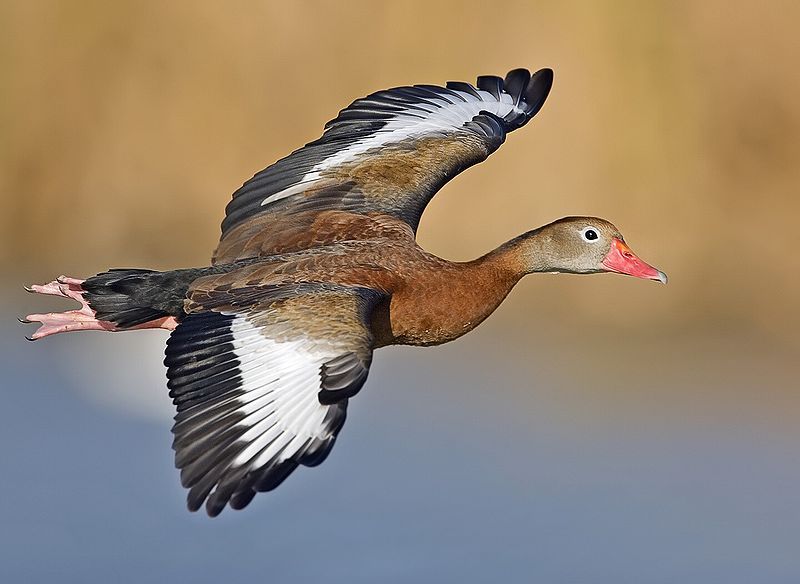
The black-bellied whistling duck, formerly known as the black-bellied tree duck, is a species of whistling duck primarily found in the southern United States, Mexico, and Central and South America before 2000.
It has since become a common sight throughout much of the United States and can now be seen year-round. This duck is unique in its appearance, with its black wings, white belly, and bright red bill.
It is also known for its distinctive whistle-like call, used to communicate with other ducks in its flock. The black-bellied whistling duck is an omnivore and feeds on aquatic vegetation, small fish, insects, and grains.
It is also known to inhabit freshwater and saltwater wetlands and can often be seen in ponds, marshes, and flooded fields. This duck is also highly social and prefers to live in large groups.
They are known to form strong bonds with other ducks and often spend their days foraging, preening, and resting together in their flocks.
| Kingdom | Animalia |
| Phylum | Chordata |
| Class | Aves |
| Order | Anseriformes |
| Family | Anatidae |
| Genus | Dendrocygna |
| Species | D. autumnalis |
14. Grey Plover
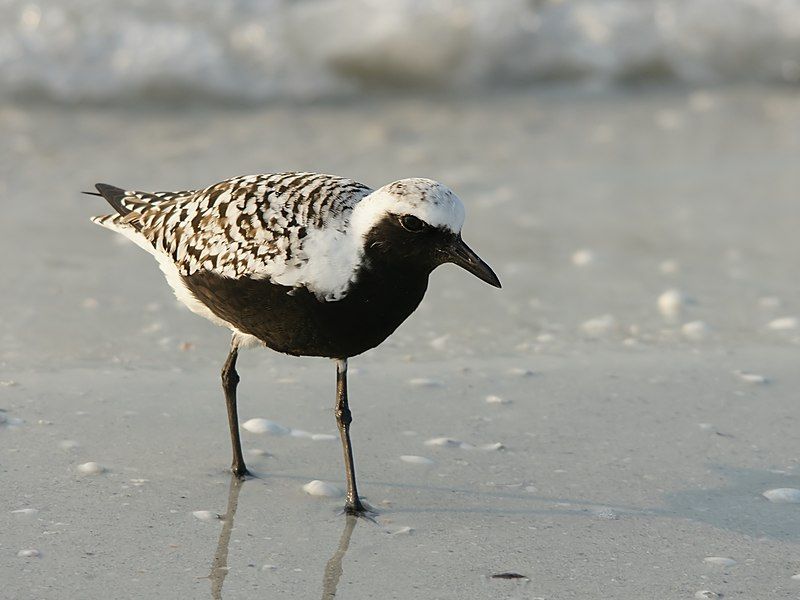
The grey plover is a species of plover found all around the world. It is also known as the black-bellied plover in North America. This species of plover is relatively large and breeds in Arctic regions.
It has a long-distance migration pattern and can be found in coastal regions worldwide when it is not breeding. This plover species is highly adaptable and can be found in many habitats, including beaches, tidal flats, and estuaries.
It feeds on small aquatic creatures like insects, crustaceans, and mollusks. The grey plover is an integral part of the coastal ecosystem and plays a vital role in controlling the populations of various small aquatic creatures.
| Kingdom | Animalia |
| Phylum | Chordata |
| Class | Aves |
| Order | Charadriiformes |
| Family | Charadriidae |
| Genus | Pluvialis |
| Species | P. squatarola |
15. Speckled Chachalaca
The speckled chachalaca is a member of the Cracidae family, which includes chachalacas, guans, and curassows. It is native to South America, inhabiting Bolivia, Brazil, Colombia, Ecuador, and Peru.
This bird species is characterized by its speckled coloration and a long, slender tail. Its neck and head are grey, and its back is brown with spots.
The underparts are white, and the wings are brown with white patches. The speckled chachalaca is a ground-dwelling bird that lives in tropical and subtropical forests and in more open areas such as second-growth forests, coffee plantations, and savannas.
It feeds mainly on fruits and seeds but will also eat insects and other invertebrates.
It spends most of its time foraging in small groups, although it can also be found alone or in pairs. The speckled chachalaca is an essential species in the tropical forests of South America, as it helps to disperse seeds and maintain a healthy ecosystem.
Unfortunately, habitat destruction due to deforestation is a significant threat to this species, and it is considered Vulnerable by the IUCN. It is also hunted for food in some areas, leading to a decline in population.
Conservation efforts are underway to protect this species and its habitat.
| Kingdom | Animalia |
| Phylum | Chordata |
| Class | Aves |
| Order | Galliformes |
| Family | Cracidae |
| Genus | Ortalis |
| Species | O. guttata |
16. Fulvous Whistling Duck
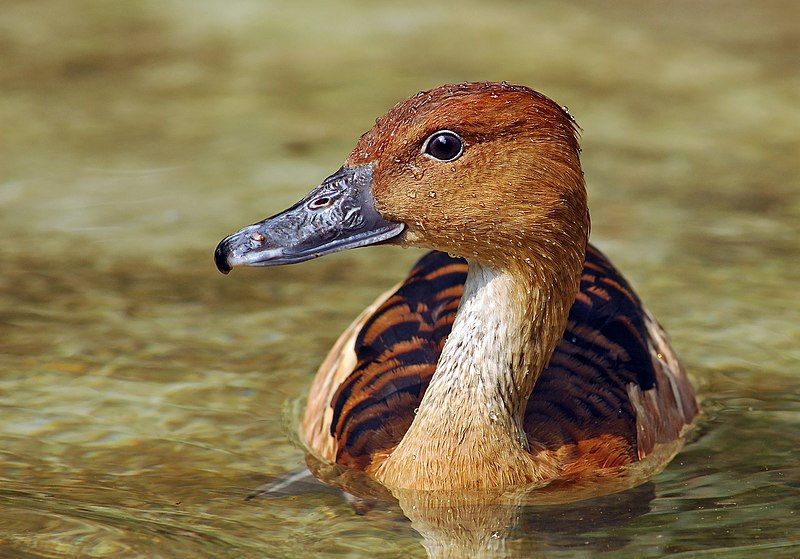
The Fulvous Whistling Duck, also known as the Fulvous Tree Duck, is a unique species of whistling duck found in many different parts of the world.
It is native to tropical regions, including much of Mexico and South America, the West Indies, the southern United States, sub-Saharan Africa, and the Indian subcontinent.
It is mainly found in wetlands and aquatic habitats, where it can feed on insects, small fish, and plant material. The Fulvous Whistling Duck is a medium-sized duck measuring 18 and 23 inches in length.
It has distinctive brown and white plumage, with dark brown feathers on its head, neck, back, and wings.
Its bill is also brown, and it has a distinctive whistling call used to communicate with other members of its species. The Fulvous Whistling Duck is an important species in many tropical regions, as it helps to maintain healthy wetland habitats.
It is also valued as a game bird and can be found in many hunting reserves. Unfortunately, it is also threatened by habitat destruction and hunting, and its population is declining in many parts of the world.
Conservation efforts are needed to ensure this species can continue thriving in its native habitats.
| Kingdom | Animalia |
| Phylum | Chordata |
| Class | Aves |
| Order | Anseriformes |
| Family | Anatidae |
| Genus | Dendrocygna |
| Species | D. bicolor |
17. Cuckoos
The Cuculidae family is a large family of birds from the order Cuculiformes. This family includes well-known species, such as the standard or European cuckoo, roadrunners, koels, malkohas, couas, coucals, and anis.
In some cases, the coucals and anis are classified as separate families, the Centropodidae and Crotophagidae, respectively. The cuckoos, the most widely known birds in the family, are found in many parts of the world.
They are known for their distinctive call and are often mistaken for the Koel, another Cuculidae family member.
The Koel is a large, long-tailed bird found mainly in the warmer parts of the world. The roadrunners are also found in the family and are smaller than the cuckoo. They are usually found in the deserts of North America and have long legs and short beaks.
The malkohas, couas, and coucals are found mainly in Africa and Asia and are characterized by their colorful feathers and long tails.
On the other hand, the Anis are found mainly in the Caribbean and South America and are distinguished by their long, curved beaks. Overall, the Cuculidae family is a diverse group of birds with many unique characteristics and habits.
They are fascinating birds to study and observe in their natural habitats.
| Kingdom | Animalia |
| Phylum | Chordata |
| Class | Aves |
| Clade | Otidimorphae |
| Order | Cuculiformes |
| Family | Cuculidae |
18. Andean Flamingo
The Andean flamingo is a species found primarily in the Andes mountains of South America. It was previously classified under the Phoenicopterus, but in 2014, it underwent a reclassification and was placed in a separate genus, Phoenicoparrus.
This is due to its close relationship with James’s flamingo, which also falls under the same genus. The two species have many similarities, including their size, habitat requirements, and diet. They are also both pink, with a distinct black stripe along the eye.
The main difference is that the Andean flamingo has a shorter neck and legs. The Andean flamingo is a threatened species due to various factors, such as habitat destruction, hunting, and the effects of climate change.
Conservation efforts are being made to protect this species and its habitat.
| Kingdom | Animalia |
| Phylum | Chordata |
| Class | Aves |
| Order | Phoenicopteriformes |
| Family | Phoenicopteridae |
| Genus | Phoenicoparrus |
| Species | P. andinus |
19. Red Shoveler
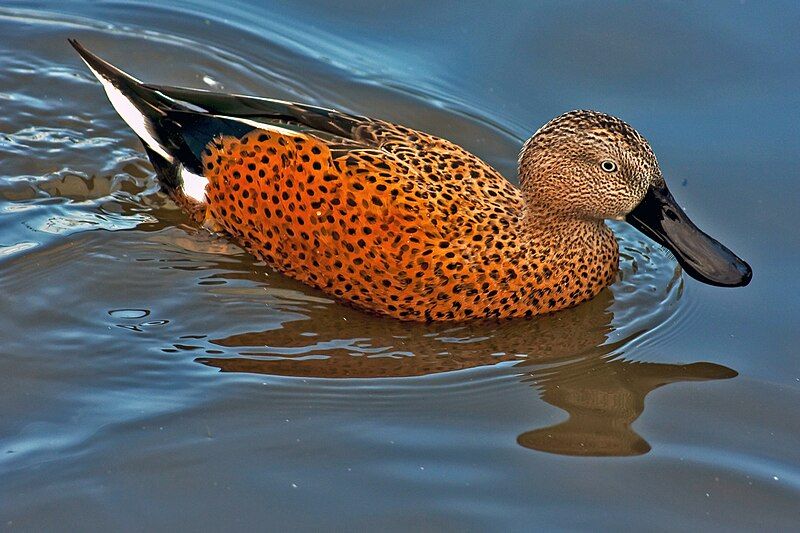
The Red Shoveler is a species of duck native to the southern regions of South America. This species of duck has a unique feature: a distinctive red bill that looks like a shovel.
The Red Shoveler is also notable for its bright blue wings and white patches on its head and neck. The Red Shoveler is a medium-sized duck, with males measuring between 45 and 50 centimeters in length.
In addition to its bright colors, the Red Shoveler is known for its habit of “dabbling,” a form of foraging in which the bird will tip its head underwater and paddle around with its feet.
The Red Shoveler feeds mainly on aquatic plants and insects, which makes it an essential part of the food chain in South American wetlands. This duck species is also necessary for the beauty it brings to its natural environment.
The bright colors of the Red Shoveler are a welcome sight in the wetlands of South America.
| Kingdom | Animalia |
| Phylum | Chordata |
| Class | Aves |
| Order | Anseriformes |
| Family | Anatidae |
| Genus | Spatula |
| Species | S. platalea |
20. Common Gallinule
The common gallinule is a bird species belonging to the Rallidae family. This species can be found in the Americas, living on the outskirts of vegetated marshes, ponds, canals, and other wetlands.
It is not found in the polar regions and many tropical rainforests. The common gallinule was previously considered part of the same species as the common moorhen until the American Ornithologists’ Union split the two species in July 2011.
The common gallinule is an aquatic bird often seen swimming gracefully in shallow water or walking along the shoreline.
It has a distinctive white frontal shield, and its plumage is greenish-black. The common gallinule is an omnivorous species and feeds on various plants and small animals. Its diet mainly consists of seeds, insects, snails, aquatic plants, and small amphibians.
It often uses its long toes to help it forage in shallow waters and is also known to steal food from other birds. The common gallinule is highly social and is often seen in large flocks. The common gallinule is a reasonably noisy bird known to make loud crow-like calls.
It is also known to emit a loud “wee-wee-wee” call to attract a mate. The species also performs elaborate courtship displays to attract a mate. The common gallinule is a highly adaptable species and can inhabit various habitats.
It is an essential species in wetland ecosystems and helps keep the ecosystem balanced by consuming aquatic plants and prey species.
| Kingdom | Animalia |
| Phylum | Chordata |
| Class | Aves |
| Order | Gruiformes |
| Family | Rallidae |
| Genus | Gallinula |
| Species | G. galeata |
21. Comb Duck
The knob-billed duck, or African comb duck, is a species of waterfowl native to various geographical areas. It is in sub-Saharan Africa, Madagascar, South Asia, and Indochina.
The knob-billed duck is a type of duck that is typically found near wetlands or waterways. The knob-billed duck is a distinctive species of duck with a unique bill. It has a large, thick knob at the top of its bill, which gives it its name.
The duck uses this bill to forage for food from the muddy bottom of the wetlands and waterways it inhabits. The African comb duck, a closely related species, is also found in the same areas as the knob-billed duck. However, they have some distinct differences.
The African comb duck has a more slender bill than the knob-billed duck, and its bill is flatter and more pointed. Most taxonomic authorities classify the two species separately based on these differences.
| Kingdom | Animalia |
| Phylum | Chordata |
| Class | Aves |
| Order | Anseriformes |
| Family | Anatidae |
| Genus | Sarkidiornis |
| Species | S. melanotos |
22. Bartlett’s Tinamou
Bartlett’s tinamou is a species of South American bird that belongs to the family Tinamidae, which comprises more than 47 species of birds. They are found in lowland forests located in much of South America. They have a long neck, a large head, and a short, rounded bill.
Their plumage is usually gray or brown, with a white throat and breast. They have a short, rounded tail and short, rounded wings. Bartlett’s tinamou typically feeds on the ground, eating a variety of plant material, including fruits, seeds, and insects.
They are usually solitary birds and prefer to stay hidden in thick vegetation. They can fly but rarely take to the air, preferring to move about on foot. They are usually active during the day and can be seen foraging in the undergrowth.
Bartlett’s tinamou are monogamous and form pair bonds for life. They usually lay two to four eggs in a shallow, plant-material nest lined with leaves. Both parents take part in incubating the eggs and raising the young.
Bartlett’s tinamou is listed as a species of Least Concern by the International Union for Conservation of Nature, but their population is declining due to habitat destruction and hunting. Conservation efforts are needed to ensure the survival of this unique species.
| Kingdom | Animalia |
| Phylum | Chordata |
| Class | Aves |
| Order | Tinamiformes |
| Family | Tinamidae |
| Genus | Crypturellus |
| Species | C. bartletti |
23. Black-capped Tinamou
The black-capped tinamou is a ground-dwelling bird native to Central and South America. It is a type of tinamou, a group of small, ground-dwelling birds found in tropical and subtropical regions.
The black-capped tinamou is one of the most common tinamous and is widely distributed throughout these regions’ moist forest lowlands.
Its range extends from Mexico in the north to Paraguay and northern Argentina in the south. The black-capped tinamou has a black head and neck, with a grayish-brown back and wings. Its underparts are pale brown with dark stripes, and its tail is black with white bars.
It typically reaches a length of around 40 cm (16 inches) and a weight of up to 280 g (10 oz).
The black-capped tinamou has a loud, booming call which is often heard in the early morning and evening. The black-capped tinamou feeds mainly on the ground, eating fruits, seeds, and insects.
It is an agile runner and moves swiftly through the undergrowth, occasionally jumping up onto rocks and logs. The black-capped tinamou is mainly solitary but can form small flocks during breeding.
The birds build a simple nest of leaves and grasses on the ground, and the female lays up to four eggs. The female incubates the eggs, and the chicks are cared for by both parents.
| Kingdom | Animalia |
| Phylum | Chordata |
| Class | Aves |
| Order | Tinamiformes |
| Family | Tinamidae |
| Genus | Crypturellus |
| Species | C. atrocapillus |
24. Black Tinamou
The black tinamou is a ground-dwelling bird species native to the Andes of South America. This bird is usually found in humid forests and wooded areas of foothills and mountains.
They are typically relatively small, measuring around 30 cm (12 inches) in length, and are usually dark grey or black. They have short legs and long, slender tails, and their beaks are pointed and rather large for their body size.
They are omnivorous, feeding on various insects, fruit, and seeds. Black tinamous typically inhabit humid areas, such as tropical rainforests and the wooded regions of the Andes.
They tend to live in small flocks, mainly terrestrial birds, spending most of their time on the ground. They are usually found in the undergrowth and dense vegetation, where they can shelter from predators.
They are also known to forage for food in open grasslands and agricultural areas. The black tinamou is an adaptive species and can survive in various habitats. They are usually quite shy and are rarely seen in the open.
Despite this, they can be heard calling out in their loud, distinctive whistles. The black tinamou is a species of conservation concern due to the destruction of their natural habitat and the hunting of the species for food.
| Kingdom | Animalia |
| Phylum | Chordata |
| Class | Aves |
| Order | Tinamiformes |
| Family | Tinamidae |
| Genus | Tinamus |
| Species | T. osgoodi |
Conclusion
Birds in Julcán provide an excellent opportunity to observe nature in its purest form. They are a vital part of the local landscape and essential to keeping the environment healthy and vibrant.
With the variety of species found in the area, bird watching in Julcán is a great way to appreciate nature’s beauty and learn more about the birds that inhabit the region.